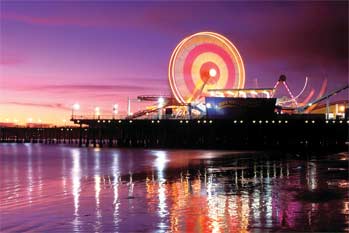Hollywood or bust
With Aer Lingus cutting their flights to LA in November the time to mingle with the stars is now. By Eoghan Corry
 There is nothing like a deadline to concentrate a tourist's mind. After the November bank holiday Aer Lingus will no longer fly direct to Los Angeles which leaves customers with a paltry four months to experience the wealth of entertainment and beach culture on offer in the city of angels. The time, it seems, is now.
There is nothing like a deadline to concentrate a tourist's mind. After the November bank holiday Aer Lingus will no longer fly direct to Los Angeles which leaves customers with a paltry four months to experience the wealth of entertainment and beach culture on offer in the city of angels. The time, it seems, is now.
Los Angeles' most obvious feature is its lack of a city centre. The many tourist hot-spots are often miles apart and without an easily available public transport system visitors and locals have come to rely on their cars. LA came of age alongside the automobile and since the car manufacturers persuaded the city officials to tear up the tram system in the 1940s the freeways are constantly clogged. There are no plans at present for a Luas-like tram revival.
Leaving the Tom Bradley terminal at LAX and heading for the sea you will find as good a base for your LA trip as any. The Spaniards founded a spring there, and in 1875 the town was laid out around Las Lágrimas de Santa Monica, literally “the tears of Santa Monica”. It sounded exotic, and 130 years later it remains that way.
This being film-star country, celebrities have played on the great sandy shores here ever since. Some built short lived homes along the beach. Any of the local tour guides who can bring you by bike, foot or even skateboard will point out where they lived and recount stories of how they played. The wiser ones, and in LA celebrity and wisdom rarely go hand in hand, stayed in the relative safety of the cliff top.
But the real celebrity here was, and is, the beach itself, enduring storm and obliteration, reconstruction and rebirth, as trends and fashions swept by with bewildering speed.
Popular culture has ingrained LA placenames into our imaginations: Malibu, Marina Del Ray and the eccentric Venice which a philanthropist developer decked out with sea canals. Each view throws up half-remembered scenes amid the shifting sands. Scenes from Baywatch were filmed on this beach. Grease was filmed at the local school. Forrest Gump set about running along the length of the pier. Then turned around. If Hollywood stands for the ephemeral, commercialised and devalued, something else is going on in Santa Monica.
But appearances can deceive; the more avant garde aspects of the local movie culture echo in every coffee house, every bar and every piece of space where creative minds are at work. One of the more extraordinary art galleries you are likely to come across is found in the strange location of an industrial estate.
Long ago they used to do New Year broadcasts from the La Monica Ballroom on the pier, reputed to be the largest ballroom in the United States and in the 1960s the Academy Awards were hosted on the pier's carousel. Anyone with no more than a passing interest in film can spend several days on tours of recognisable locations, houses of the stars, places where the famous died and the Hollywood sign itself, not forgetting the movie studios. Other cities have an outstanding range of cuisine, art and history but none can match the star spotting opportunities of LA.
Beverly Hills was virtually invented as a playhouse for the movie stars when Mary Pickford and Douglas Fairbanks moved there in 1919. Donna Punaro grew up here and now hosts Ambassador Walking Tours. With every story Punaro reminds us that LA is a real community, not something created by the celebrity culture that causes people to come and gape. On Rodeo Drive you can relive Hollywood fantasies; some of the exclusive, and expensive, shops that line the street featured in Pretty Woman.
Further on, the streets become more familiar again. Sunset Boulevard is home to the Sunset Tower hotel managed by Patrick O'Shea from Westmeath. The street next to it was named for Edward L Doheny, the Irish oil tycoon whose life story served as the model for There Will Be Blood. It was also on this street that Marilyn Monroe committed suicide.
Captain Peter W Damisch brings holiday makers on yacht trips from nearby Marina Del Ray. One of the largest man-made small boat harbours in the US: 5,300 ships can berth at its 19 marinas. It is located four miles north of Los Angeles International Airport and flight crews, including that of Aer Lingus, use downtime to sail pleasure craft past the sea lions bathing at the breakwater at the harbour's mouth.
The wildlife has teemed since the breakwater was built. Sometimes other, less friendly, animals come to play. “Sharks only want peace,” Damisch says, “a piece of you and a piece of everyone else”.
The Oceana Hotel's huge rooms, they were once apartments, are one of the reasons the hotel is one of many where the growing numbers of Irish people, who visit LA, come to stay. The hotels come in all shapes and sizes, Hotel Carmel is a beachfront original and The Shangri-La Hotel a historical gem and Pacific beachfront landmark.
It is the optimism of LA that wins through in the end. They say those who headed west in hope of a better life grew more optimistic by the mile. By the time they reached the Pacific the optimism shone through and the most optimistic of all were to be found on the pier of Santa Monica.
